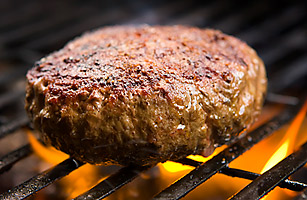
By Josh Ozersky
First appeared on Time.com
Rarely has anything so small done so much to ruin so many hamburgers as E. coli bacteria has. It’s not just the actual burgers they infect, it’s the response they provoke, which ruins so many innocent, untainted ones. With the European outbreak growing to record proportions (23 dead and 2,000 ill at the time of writing), you have to think that U.S. authorities will become even more vigilant in their hunt for E. coli Stateside.
Part of that, inevitably, will involve overcooking hamburgers. In Europe, authorities believe that the new strain is being carried by vegetables, but E. coli’s most common vector is ground beef. It’s a nasty germ, but not a particularly resilient one; it can be killed by cooking meat to 160°F, which is approximately medium-well done. To me, a world in which no one ever eats a pink, juicy hamburger is one that’s hardly worth living in, so my position has always been to just eat good, freshly ground beef from a local butcher, rather than produced by the ton in vast death mills a thousand miles away. My friend Pat LaFrieda, whose family has been grinding burger meat for three generations, says he has never heard of someone getting an E. coli infection from freshly ground meat, and that’s good enough for me. (Can anyone improve upon the classic burger?)
But there are some dissenters, even among my fellow meat pundits. Craig “Meathead” Goldwyn, who writes about meat and grilling for the Huffington Post and whose microbiologist wife works for the FDA, thinks that’s not good enough. We recently had a spirited e-mail exchange in which he pointed out that there’s no way to be sure that E. coli isn’t living inside ground meat. (If it lives on the surface of a steak, that doesn’t matter, because the broiler’s heat will kill it.) “My wife,” Meathead writes, “calls it the microbiological load. Almost all meat has some E. coli on it nowadays, no matter the source. But if it is kept cold and processed and handled quickly, the bugs don’t have a chance to multiply to a level that can harm normal people. But they multiply rapidly once they get out of the cold. So if your chuck steak was cut from a steer killed upstate last week, boxed, shipped in a reefer that has a balky AC to your butcher and he has a 20-year-old grinder not in the cold room, and he cleans it only at closing time, and your fridge is an antique and you never adjust the temp, you could kill somebody with a compromised immune system and you would never even know it.”
Whoa. But surely there must be some way to kill E. coli without murdering the burger along with it? There is, but you’re not going to like it. It’s called irradiated beef, and it’s being hailed as a magic bullet for the pre-emptive destruction of multiple pathogens including salmonella and E. coli. I first read about it in an article in Beef magazine. The process would require a radioactivity symbol on the meat, and even the author of the article, who is so enthusiastic that you begin to suspect that he owns an electron mine, admits that the meat is likely to taste at least a little weird after passing through the radiation cloud.
Such extreme measures might turn out to be unnecessary. In his excellent guide to food safety, Meathead points out that the sous-vide technique, in which the meat is poached for a long time in a bag in a water bath, actually allows you to cook the meat to 130°F, medium rare, and still get the germs. It takes much longer for them to be wiped out at this lower temperature; but since the point of sous-vide cooking is that the food can never get hotter than the temperature of the water bath, you can just leave the meat in there as long as you want. The only problems are that 1) nobody has a sous-vide machine at home and 2) sous-vide hamburgers are terrible. You can also dip a steak in boiling water and then grind it yourself, but no one is realistically going to do that either.
The truth of the matter is that when you eat food, you are generally eating living things. Every bite you take, no matter how hermetically sealed and thrice purified, is teeming with microbes. And so are you. In fact, you are also teeming with animals, which are teeming with microbes. If you dodge one, it’s wholly possible that another will have its way with you. The best counsel, I would say, is to gather your courage, eat good meat and hope for the best. The alternatives are just too depressing to consider.
___________________________________________________________________________________________
Ozersky is a James Beard Award–winning food writer and the author of The Hamburger: A History. You can listen to his weekly show at the Heritage Radio Network and read his column on home cooking at Rachael Ray’s website. He is currently at work on a biography of Colonel Sanders.
